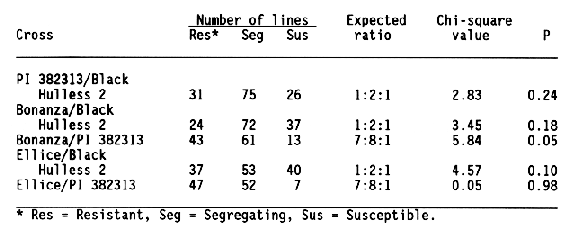

On the North American plains durable resistance to Puccinia graminis f. sp. tritici in barley has been conferred by the T (Rpg1) gene (Lejune, 1946). However, changing virulence of this pathogen requires that new sources of resistance be found.
A new gene for stem rust resistance has been identified in PI 382313 (Jedel et al., 1989). In seedling tests PI 382313 was resistant or moderately resistant to six races of stem rust, C5 (HTC), C10 (?), C17 (MCC), C25 (QTH), C35 (RKQ) and C53 (TPM) (International nomenclature, Roelfs and Martens, 1988). In adult plant tests from 1986 to 1988, PI 382313 performed as well as, or better than, cultivars known to possess Rpg1 (Table 1). Genetic studies indicated that the resistance of PI 382313 was conferred by a single gene that differed from Rpg1 (Table 2).
We have named the new gene Rpg3c (T3). In field tests, the resistance of Rpg1 and Rpg3 appeared to be complimentary as resistance of some F3 lines was better than either parent. Resistance of these lines has continued to be better than either Rpgl or Rpg3 alone (Dr. P. Dyck, Agriculture Canada Research Station, Winnipeg, Manitoba, Canada).


References:
Jedel, P. E., D. R. Metcalfe, and J. W. Martens. 1989. Assessment of barley accessions PI 382313, PI 382474, PI 382915, and PI 38976 for stem rust resistance. Crop Sci. 29:1473-1477.
Lejune, A. J. 1946. Correlated inheritance of stem rust reaction, nitrogen content of grain and kernel weight in a barley cross. Sci. Agric. (Ottawa) 26:198-211.
Roelfs, A. P., and J. W. Martens. 1988. An international system of nomenclature for Puccinia graminis f. sp. tritici. Phytopathology 78:526-533.